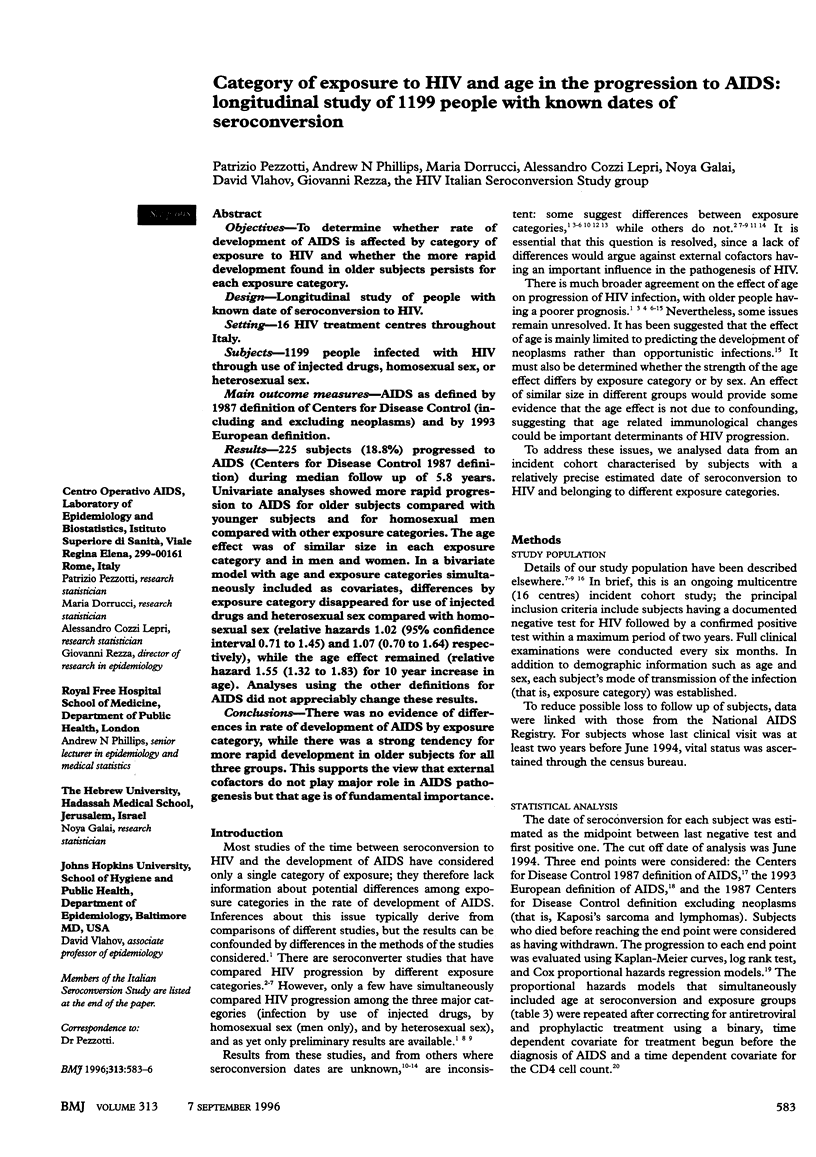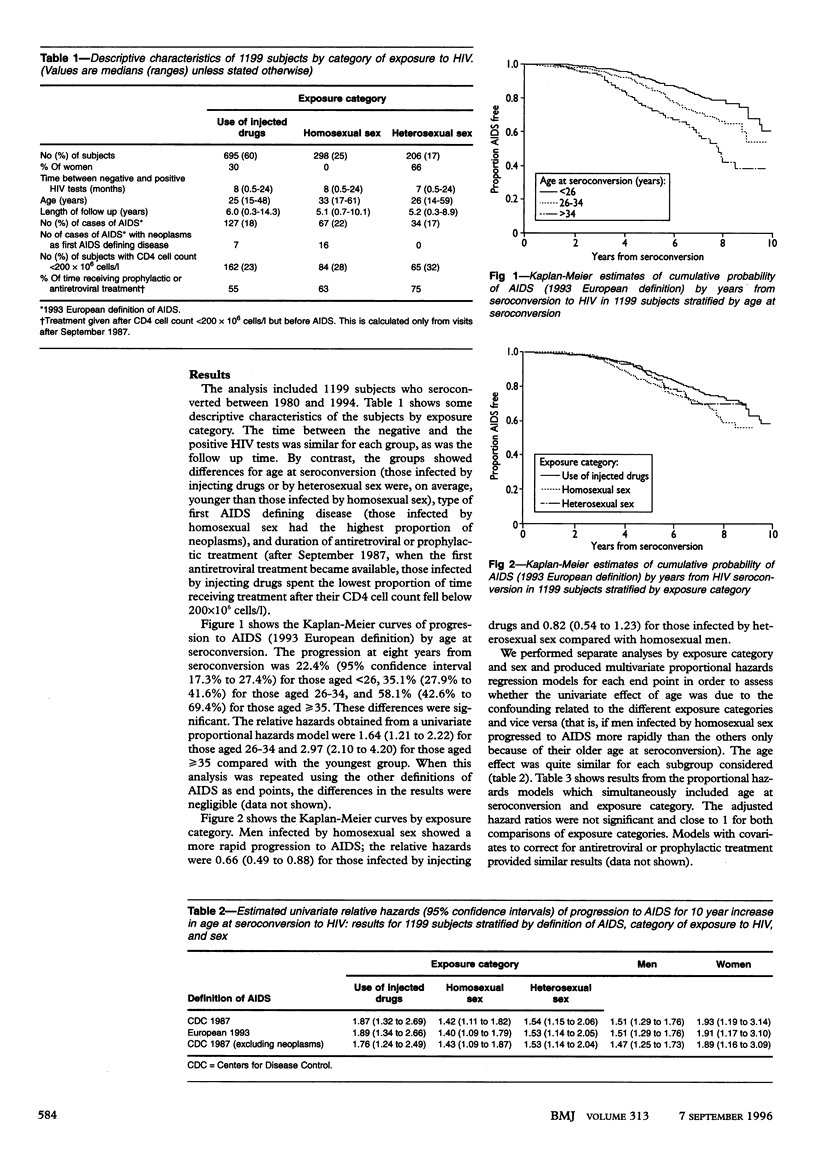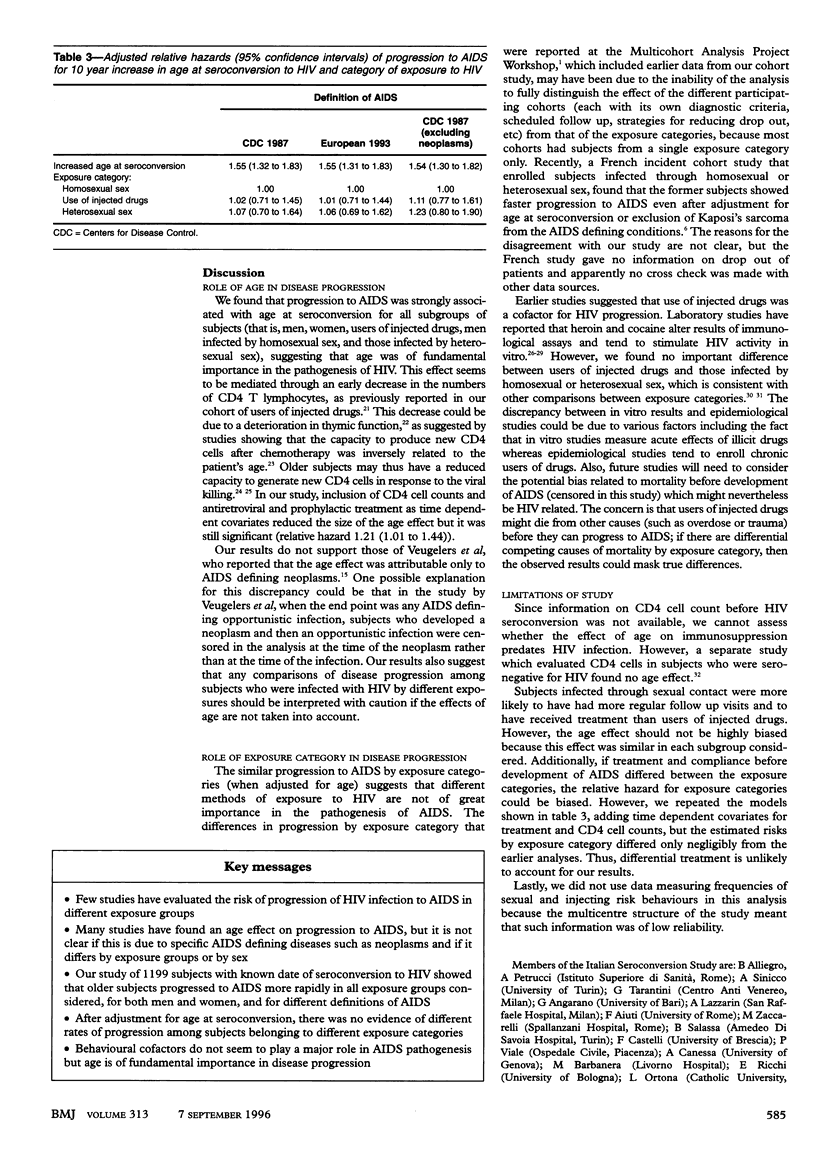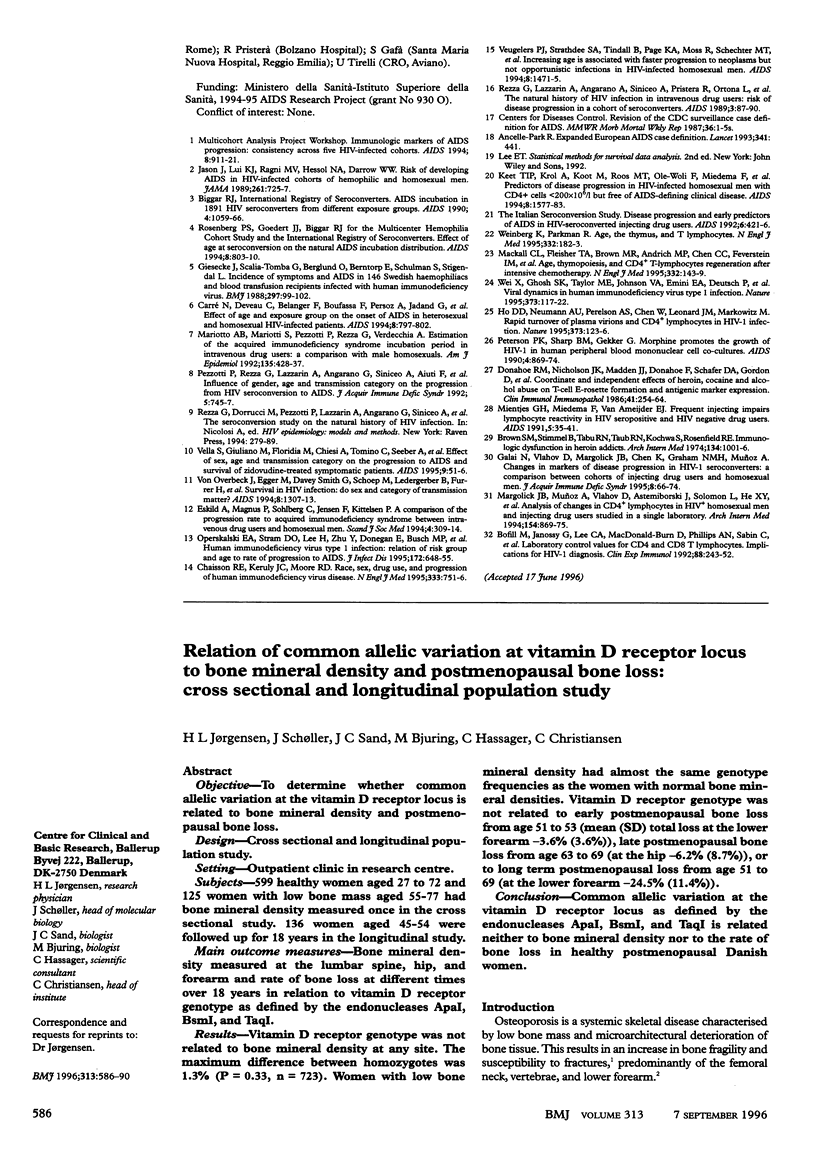Abstract
OBJECTIVES: To determine whether rate of development of AIDS is affected by category of exposure to HIV and whether the more rapid development found in older subjects persists for each exposure category. DESIGN: Longitudinal study of people with known date of seroconversion to HIV. SETTING: 16 HIV treatment centres throughout Italy. SUBJECTS: 1199 people infected with HIV through use of injected drugs, homosexual sex, or heterosexual sex. MAIN OUTCOME MEASURES: AIDS as defined by 1987 definition of Centers for Disease Control (including and excluding neoplasms) and by 1993 European definition. RESULTS: 225 subjects (18.8%) progressed to AIDS (Centers for Disease Control 1987 definition) during median follow up of 5.8 years. Univariate analyses showed more rapid progression to AIDS for older subjects compared with younger subjects and for homosexual men compared with other exposure categories. The age effect was of similar size in each exposure category and in men and women. In a bivariate model with age and exposure categories simultaneously included as covariates, differences by exposure category disappeared for use of injected drugs and heterosexual sex compared with homosexual sex (relative hazards 1.02 (95% confidence interval 0.71 to 1.45) and 1.07 (0.70 to 1.64) respectively), while the age effect remained (relative hazard 1.55 (1.32 to 1.83) for 10 year increase in age). Analyses using the other definitions for AIDS did not appreciably change these results. CONCLUSIONS: There was no evidence of differences in rate of development of AIDS by exposure category, while there was a strong tendency for more rapid development in older subjects for all three groups. This supports the view that external cofactors do not play major role in AIDS pathogenesis but that age is of fundamental importance.
Full text
PDF



Selected References
These references are in PubMed. This may not be the complete list of references from this article.
- Ancelle-Park R. Expanded European AIDS case definition. Lancet. 1993 Feb 13;341(8842):441–441. doi: 10.1016/0140-6736(93)93040-8. [DOI] [PubMed] [Google Scholar]
- Biggar R. J. AIDS incubation in 1891 HIV seroconverters from different exposure groups. International Registry of Seroconverters. AIDS. 1990 Nov;4(11):1059–1066. doi: 10.1097/00002030-199011000-00002. [DOI] [PubMed] [Google Scholar]
- Bofill M., Janossy G., Lee C. A., MacDonald-Burns D., Phillips A. N., Sabin C., Timms A., Johnson M. A., Kernoff P. B. Laboratory control values for CD4 and CD8 T lymphocytes. Implications for HIV-1 diagnosis. Clin Exp Immunol. 1992 May;88(2):243–252. doi: 10.1111/j.1365-2249.1992.tb03068.x. [DOI] [PMC free article] [PubMed] [Google Scholar]
- Brown S. M., Stimmel B., Taub R. N., Kochwa S., Rosenfield R. E. Immunologic dysfunction in heroin addicts. Arch Intern Med. 1974 Dec;134(6):1001–1006. [PubMed] [Google Scholar]
- Carré N., Deveau C., Belanger F., Boufassa F., Persoz A., Jadand C., Rouzioux C., Delfraissy J. F., Bucquet D. Effect of age and exposure group on the onset of AIDS in heterosexual and homosexual HIV-infected patients. SEROCO Study Group. AIDS. 1994 Jun;8(6):797–802. doi: 10.1097/00002030-199406000-00012. [DOI] [PubMed] [Google Scholar]
- Chaisson R. E., Keruly J. C., Moore R. D. Race, sex, drug use, and progression of human immunodeficiency virus disease. N Engl J Med. 1995 Sep 21;333(12):751–756. doi: 10.1056/NEJM199509213331202. [DOI] [PubMed] [Google Scholar]
- Donahoe R. M., Nicholson J. K., Madden J. J., Donahoe F., Shafer D. A., Gordon D., Bokos P., Falek A. Coordinate and independent effects of heroin, cocaine, and alcohol abuse on T-cell E-rosette formation and antigenic marker expression. Clin Immunol Immunopathol. 1986 Nov;41(2):254–264. doi: 10.1016/0090-1229(86)90109-1. [DOI] [PubMed] [Google Scholar]
- Eskild A., Magnus P., Sohlberg C., Jensen F., Kittelsen P. A comparison of the progression rate to acquired immunodeficiency syndrome between intravenous drug users and homosexual men. Scand J Soc Med. 1994 Dec;22(4):309–314. doi: 10.1177/140349489402200411. [DOI] [PubMed] [Google Scholar]
- Galai N., Vlahov D., Margolick J. B., Chen K., Graham N. M., Muñoz A. Changes in markers of disease progression in HIV-1 seroconverters: a comparison between cohorts of injecting drug users and homosexual men. J Acquir Immune Defic Syndr Hum Retrovirol. 1995 Jan 1;8(1):66–74. [PubMed] [Google Scholar]
- Giesecke J., Scalia-Tomba G., Berglund O., Berntorp E., Schulman S., Stigendal L. Incidence of symptoms and AIDS in 146 Swedish haemophiliacs and blood transfusion recipients infected with human immunodeficiency virus. BMJ. 1988 Jul 9;297(6641):99–102. doi: 10.1136/bmj.297.6641.99. [DOI] [PMC free article] [PubMed] [Google Scholar]
- Ho D. D., Neumann A. U., Perelson A. S., Chen W., Leonard J. M., Markowitz M. Rapid turnover of plasma virions and CD4 lymphocytes in HIV-1 infection. Nature. 1995 Jan 12;373(6510):123–126. doi: 10.1038/373123a0. [DOI] [PubMed] [Google Scholar]
- Jason J., Lui K. J., Ragni M. V., Hessol N. A., Darrow W. W. Risk of developing AIDS in HIV-infected cohorts of hemophilic and homosexual men. JAMA. 1989 Feb 3;261(5):725–727. [PubMed] [Google Scholar]
- Keet I. P., Krol A., Koot M., Roos M. T., de Wolf F., Miedema F., Coutinho R. A. Predictors of disease progression in HIV-infected homosexual men with CD4+ cells < 200 x 10(6)/l but free of AIDS-defining clinical disease. AIDS. 1994 Nov;8(11):1577–1583. doi: 10.1097/00002030-199411000-00009. [DOI] [PubMed] [Google Scholar]
- Mackall C. L., Fleisher T. A., Brown M. R., Andrich M. P., Chen C. C., Feuerstein I. M., Horowitz M. E., Magrath I. T., Shad A. T., Steinberg S. M. Age, thymopoiesis, and CD4+ T-lymphocyte regeneration after intensive chemotherapy. N Engl J Med. 1995 Jan 19;332(3):143–149. doi: 10.1056/NEJM199501193320303. [DOI] [PubMed] [Google Scholar]
- Margolick J. B., Muñoz A., Vlahov D., Astemborski J., Solomon L., He X. Y., Nelson K. E., Saah A. J. Direct comparison of the relationship between clinical outcome and change in CD4+ lymphocytes in human immunodeficiency virus-positive homosexual men and injecting drug users. Arch Intern Med. 1994 Apr 25;154(8):869–875. [PubMed] [Google Scholar]
- Mariotto A. B., Mariotti S., Pezzotti P., Rezza G., Verdecchia A. Estimation of the acquired immunodeficiency syndrome incubation period in intravenous drug users: a comparison with male homosexuals. Am J Epidemiol. 1992 Feb 15;135(4):428–437. doi: 10.1093/oxfordjournals.aje.a116303. [DOI] [PubMed] [Google Scholar]
- Mientjes G. H., Miedema F., van Ameijden E. J., van den Hoek A. A., Schellekens P. T., Roos M. T., Coutinho R. A. Frequent injecting impairs lymphocyte reactivity in HIV-positive and HIV-negative drug users. AIDS. 1991 Jan;5(1):35–41. doi: 10.1097/00002030-199101000-00005. [DOI] [PubMed] [Google Scholar]
- Operskalski E. A., Stram D. O., Lee H., Zhou Y., Donegan E., Busch M. P., Stevens C. E., Schiff E. R., Dietrich S. L., Mosley J. W. Human immunodeficiency virus type 1 infection: relationship of risk group and age to rate of progression to AIDS. Transfusion Safety Study Group. J Infect Dis. 1995 Sep;172(3):648–655. doi: 10.1093/infdis/172.3.648. [DOI] [PubMed] [Google Scholar]
- Peterson P. K., Sharp B. M., Gekker G., Portoghese P. S., Sannerud K., Balfour H. H., Jr Morphine promotes the growth of HIV-1 in human peripheral blood mononuclear cell cocultures. AIDS. 1990 Sep;4(9):869–873. doi: 10.1097/00002030-199009000-00006. [DOI] [PubMed] [Google Scholar]
- Pezzotti P., Rezza G., Lazzarin A., Angarano G., Sinicco A., Aiuti F., Zerboni R., Salassa B., Gafà S., Pristerà R. Influence of gender, age, and transmission category on the progression from HIV seroconversion to AIDS. J Acquir Immune Defic Syndr. 1992;5(7):745–747. [PubMed] [Google Scholar]
- Rezza G., Lazzarin A., Angarano G., Sinicco A., Pristerà R., Ortona L., Barbanera M., Gafà S., Tirelli U., Salassa B. The natural history of HIV infection in intravenous drug users: risk of disease progression in a cohort of seroconverters. AIDS. 1989 Feb;3(2):87–90. doi: 10.1097/00002030-198902000-00006. [DOI] [PubMed] [Google Scholar]
- Vella S., Giuliano M., Floridia M., Chiesi A., Tomino C., Seeber A., Barcherini S., Bucciardini R., Mariotti S. Effect of sex, age and transmission category on the progression to AIDS and survival of zidovudine-treated symptomatic patients. AIDS. 1995 Jan;9(1):51–56. doi: 10.1097/00002030-199501000-00007. [DOI] [PubMed] [Google Scholar]
- Wei X., Ghosh S. K., Taylor M. E., Johnson V. A., Emini E. A., Deutsch P., Lifson J. D., Bonhoeffer S., Nowak M. A., Hahn B. H. Viral dynamics in human immunodeficiency virus type 1 infection. Nature. 1995 Jan 12;373(6510):117–122. doi: 10.1038/373117a0. [DOI] [PubMed] [Google Scholar]
- Weinberg K., Parkman R. Age, the thymus, and T lymphocytes. N Engl J Med. 1995 Jan 19;332(3):182–183. doi: 10.1056/NEJM199501193320310. [DOI] [PubMed] [Google Scholar]
- von Overbeck J., Egger M., Smith G. D., Schoep M., Ledergerber B., Furrer H., Malinverni R. Survival in HIV infection: do sex and category of transmission matter? Swiss HIV Cohort Study. AIDS. 1994 Sep;8(9):1307–1313. doi: 10.1097/00002030-199409000-00014. [DOI] [PubMed] [Google Scholar]


